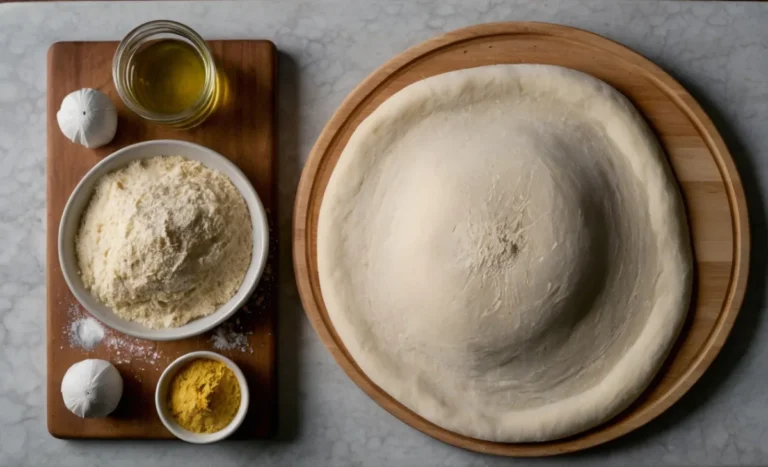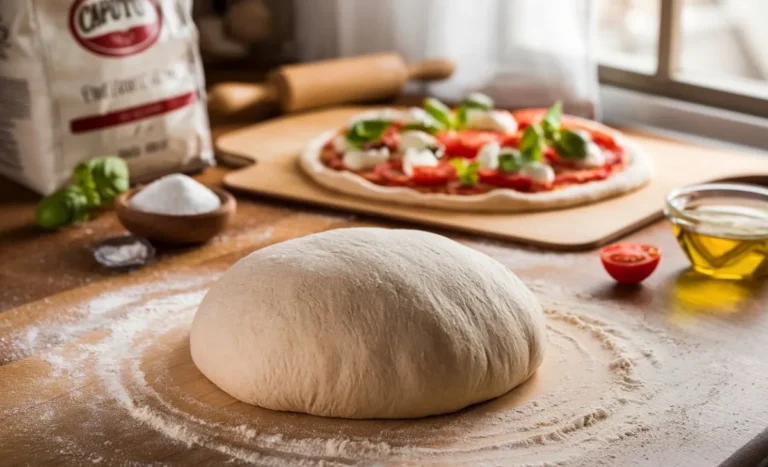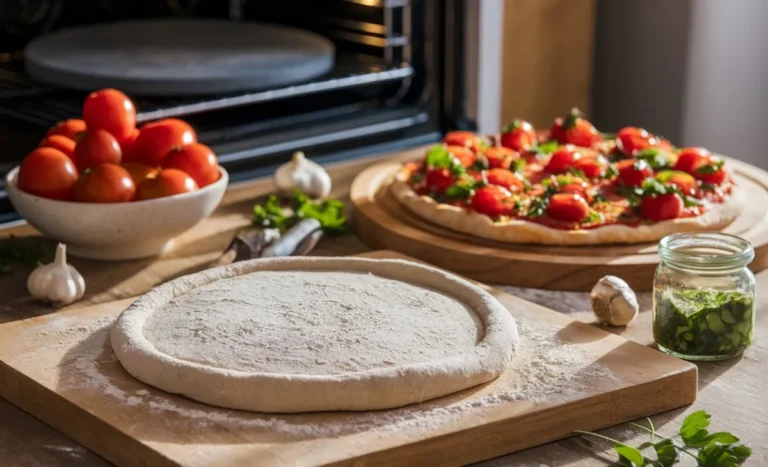The Ultimate Guide to Choosing the Best Pizza Flour for Perfect Homemade Pizzas
Understanding the Different Types of Pizza Flour
Choosing the right pizza flour is essential for crafting the perfect homemade pizza. Understanding the various types of pizza flour available can help you achieve the ideal crust, whether you’re aiming for thin and crispy or soft and chewy. With the right knowledge, you’ll be able to select the flour that complements your recipe and enhances your pizza-making skills. Let’s explore the different types of pizza flour and how they affect your dough.
One of the most commonly used types is all-purpose flour. It’s versatile and readily available, making it a go-to option for many home cooks. With a moderate protein content of around 10-12%, all-purpose flour creates a balance between chewiness and crispiness. However, it may not provide the same structure and elasticity as higher-protein flours, which are often preferred for specific pizza styles.
For a stronger and chewier crust, bread flour is the top choice. It has a higher protein content, usually around 12-14%, which results in a more robust dough with better gluten development. Bread flour is ideal for pizzas with a thicker crust or those that require a strong foundation, like New York-style pizzas. Its added strength ensures that the dough can rise and hold its shape while baking.
If you’re looking for a more traditional pizza crust, 00 flour is often recommended. This finely milled flour originates from Italy and is the preferred choice for making authentic Neapolitan pizzas. With a lower protein content than bread flour, around 11-12%, 00 flour produces a light and airy crust. Its unique texture allows the dough to stretch easily, creating the signature thin, soft base that Neapolitan pizzas are known for.
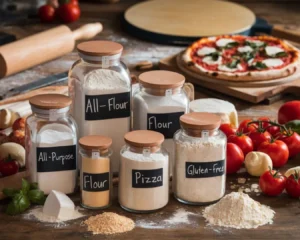
Key Factors to Consider When Choosing Pizza Flour
Selecting the right pizza flour is crucial for achieving the perfect dough texture and flavor. Whether you’re a novice or an experienced pizza maker, understanding the key factors in choosing the best flour can significantly impact your results. By considering these elements, you’ll be able to create a dough that meets your specific needs, ensuring your homemade pizzas turn out exactly as you envision. Let’s dive into the important factors that will help guide your flour selection.
First, the protein content of the flour plays a major role in determining your dough’s texture. Flours with higher protein content, like bread flour, develop more gluten, resulting in a chewier and stronger crust. If you’re aiming for a thin and crisp pizza, you might want to choose a flour with lower protein, such as all-purpose or 00 flour. Understanding how protein influences the structure will help you achieve the right balance of chewiness and tenderness in your pizza.
Another key factor to consider is the type of pizza you plan to make. Different styles of pizza require different dough characteristics. For example, a New York-style pizza needs a strong, chewy dough that holds up well under heavier toppings, making bread flour an excellent choice. Meanwhile, if you’re crafting a classic Neapolitan pizza, 00 flour is preferred for its soft, elastic dough that cooks quickly in high-heat ovens.
Finally, don’t overlook the importance of hydration levels when selecting pizza flour. Some flours absorb more water than others, which affects how easy the dough is to work with. For instance, bread flour tends to absorb more water, creating a stiffer dough that’s easier to shape but harder to stretch. On the other hand, all-purpose and 00 flour require less water, resulting in a softer dough that’s more pliable and easier to handle. By keeping hydration levels in mind, you’ll ensure your dough is manageable and yields the perfect pizza crust.
Comparing All-Purpose Flour vs. Bread Flour for Pizza
When making homemade pizza, choosing the right pizza flour can make all the difference in the texture and flavor of your crust. Two popular options are all-purpose flour and bread flour, both offering distinct results. Understanding the differences between these types of flour will help you decide which is best suited for your pizza-making needs. In this section, we’ll compare all-purpose flour and bread flour to see how each one impacts your pizza crust.
All-purpose flour is a versatile choice for many recipes, including pizza. With a moderate protein content of around 10-12%, it strikes a balance between chewiness and crispiness. This flour is ideal if you’re looking to make a pizza with a thinner, more delicate crust. It’s also more readily available, making it a convenient option for home cooks. However, it may not provide the same level of gluten development as bread flour, which can affect the dough’s elasticity.
Bread flour, on the other hand, contains a higher protein content, usually between 12-14%. This added protein allows for more gluten formation, giving the dough a chewier texture and stronger structure. If you prefer a thicker, more robust crust with a satisfying bite, bread flour is the way to go. Additionally, bread flour helps the dough rise better, creating air pockets that give the crust a lighter, airy quality, which is perfect for New York-style or Sicilian pizzas.
While both types of flour can produce excellent pizza, the choice ultimately depends on the style of pizza you want. All-purpose flour works well for pizzas with a soft, crispy base, while bread flour is perfect for pizzas that need extra strength and chewiness. By experimenting with these different flours, you can discover which one helps you achieve your ideal pizza crust.
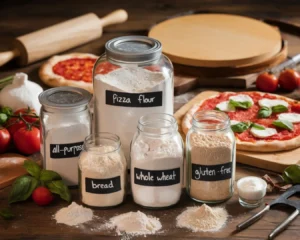
Exploring Specialty Flours for Unique Pizza Crusts
Using specialty pizza flour is a great way to elevate your homemade pizza and create a unique crust. While traditional flours like all-purpose and bread flour are reliable options, specialty flours can offer new textures and flavors. For those looking to experiment beyond the standard choices, there are several exciting options available. In this section, we’ll explore some specialty flours that can help you craft distinctive pizza crusts.
One popular option is whole wheat flour, which adds a hearty, nutty flavor to your pizza crust. This flour is higher in fiber and nutrients compared to refined flours, making it a healthier choice. However, because whole wheat flour has a lower gluten content, it tends to create a denser crust. To balance this, many bakers mix whole wheat flour with bread flour to maintain the chewiness while still enjoying the rich flavor.
Another intriguing choice is semolina flour, which is made from durum wheat and has a coarser texture. Often used in pasta making, semolina flour can give your pizza crust a slightly crisp and crunchy finish. Its golden color also enhances the visual appeal of the pizza. When mixed with other flours, like all-purpose or 00 flour, semolina adds a delightful texture that sets your crust apart from the traditional options.
For those interested in gluten-free alternatives, almond flour is a fantastic option. Made from ground almonds, this flour provides a subtle nutty flavor and a softer, more tender crust. Since it lacks gluten, almond flour requires a binding agent like xanthan gum or eggs to help the dough hold together. While gluten-free doughs have a different texture, almond flour allows pizza lovers with gluten sensitivities to enjoy a delicious and unique homemade crust.
How Protein Content Affects Pizza Dough
When it comes to making the perfect pizza, the protein content in your pizza flour plays a crucial role in shaping the dough’s texture and structure. Protein directly influences the amount of gluten formed during the mixing process, which affects how your dough rises, stretches, and bakes. Whether you want a thin, crispy crust or a thick, chewy one, understanding how protein content impacts your pizza dough is key. In this section, we’ll explore the connection between protein levels and dough performance.
Flours with higher protein content, such as bread flour, contain more gluten-forming potential. This gluten gives the dough its elasticity and strength, allowing it to hold its shape and rise during baking. As a result, high-protein flours are perfect for making chewy, sturdy pizza crusts that can support heavier toppings. For pizzas like New York-style or Sicilian, a high-protein flour helps create the dense, satisfying bite these styles are known for.
On the other hand, flours with lower protein content, like all-purpose or 00 flour, produce a softer dough with less gluten development. This results in a lighter, more tender crust that’s ideal for thin-crust pizzas. Neapolitan pizza, for instance, relies on 00 flour’s moderate protein content to create its signature soft, slightly chewy base. Low-protein flours allow the dough to stretch easily, making them perfect for styles that require a more delicate texture.
Finding the right balance of protein content is essential for achieving your desired pizza crust. If you’re aiming for a crisp, airy base, a lower-protein flour will give you the lightness you need. But if you want a heartier, chewier crust, opting for a high-protein flour will help you get there. By understanding how protein content affects your dough, you can make more informed choices when selecting the best pizza flour for your homemade creations.
Best Pizza Flour for Thin Crust vs. Thick Crust Pizzas
Choosing the right pizza flour is essential when deciding between thin and thick crust pizzas. The type of flour you use can dramatically affect the texture, crispness, and overall experience of your pizza. Whether you love a light and crispy base or a thick, chewy crust, selecting the appropriate flour will help you achieve the perfect dough. Let’s explore the best pizza flours for thin crust and thick crust pizzas, and how they make a difference in your homemade creations.
For a thin crust pizza, flours with a lower protein content are often the best choice. All-purpose flour or 00 flour, which both have moderate protein levels, are ideal for creating a light, crispy crust. These flours develop less gluten, which allows the dough to stretch thin without becoming overly chewy. Neapolitan-style pizzas, known for their thin, soft bases with a slightly crispy edge, typically use 00 flour to achieve that delicate balance.
When making a thick crust pizza, a flour with higher protein content is recommended. Bread flour, with its strong gluten-forming properties, provides the elasticity and strength needed to support a thick, hearty dough. This extra gluten helps the dough rise more, creating a soft yet chewy interior. Thick crust styles like Chicago deep-dish or Sicilian pizza benefit from bread flour’s ability to produce a more substantial and airy dough that holds its shape during baking.
Ultimately, the best pizza flour depends on the style you’re aiming for. Thin crust lovers will find that low-protein flours create the light, crisp base they desire, while thick crust enthusiasts should turn to higher-protein flours for the ideal texture and rise. By understanding these differences, you can confidently choose the right flour and make your pizza exactly how you like it.
Tips for Storing and Using Pizza Flour for Optimal Results
Storing and using your pizza flour correctly is just as important as choosing the right type for your dough. To achieve the perfect pizza crust, it’s essential to store your flour properly to preserve its freshness and know how to handle it when making dough. With a few simple tips, you can ensure that your pizza flour stays in top condition, helping you create amazing homemade pizzas every time. Below, we’ll guide you through the steps for storing and using your pizza flour for optimal results, along with a step-by-step recipe.

Tips for Storing Pizza Flour
- Keep it cool and dry: Store your pizza flour in an airtight container to protect it from moisture and humidity. Keep it in a cool, dry place, like a pantry or cupboard. ️
- Use the freezer for long-term storage: If you don’t use flour often, store it in the freezer to extend its shelf life. Make sure it’s sealed tightly in a freezer-safe bag. ❄️
- Label with dates: Always mark your flour container with the date you opened it. This will help you track freshness, as flour typically lasts about 6-12 months. ️
Tips for Using Pizza Flour
- Measure accurately: Use a kitchen scale for precise measurements. The right amount of flour is key to perfect dough consistency. ⚖️
- Sift before mixing: Sifting your flour helps remove any clumps and adds air, which can lead to a lighter, fluffier crust.
- Allow time for resting: After mixing your dough, let it rest to allow the gluten to develop fully. This improves elasticity and texture. ⏲️
Ingredients for Pizza Dough:
- 3 ½ cups pizza flour (bread or all-purpose)
- 1 packet active dry yeast
- 1 ½ teaspoons salt
- 1 cup warm water
- 1 tablespoon olive oil
Step-by-Step Cooking Instructions:
- Mix dry ingredients: In a large bowl, combine flour, yeast, and salt. Stir well to blend.
- Add water and oil: Slowly add the warm water and olive oil to the dry mixture. Stir until it forms a dough.
- Knead the dough: Turn the dough out onto a floured surface and knead for 8-10 minutes until smooth and elastic.
- Let it rise: Place the dough in a lightly oiled bowl, cover with a damp towel, and let it rise in a warm area for 1-2 hours. ⏳
- Shape the dough: Punch the dough down, then roll or stretch it into your desired pizza shape.
- Top and bake: Add your favorite toppings and bake at 475°F (245°C) for 10-15 minutes, or until golden and crispy.
By following these storage and usage tips, along with the recipe above, you’ll be well on your way to making pizzas with the best possible crust!
Creamy and Spicy Rotel Dip Recipe: Perfect for Game Day Gatherings



